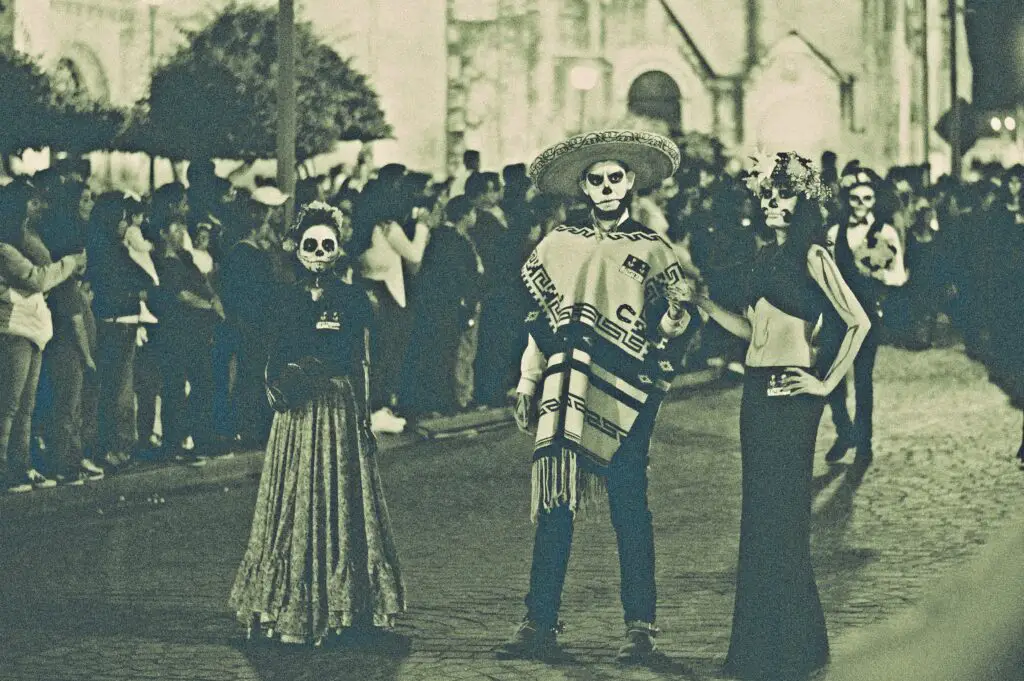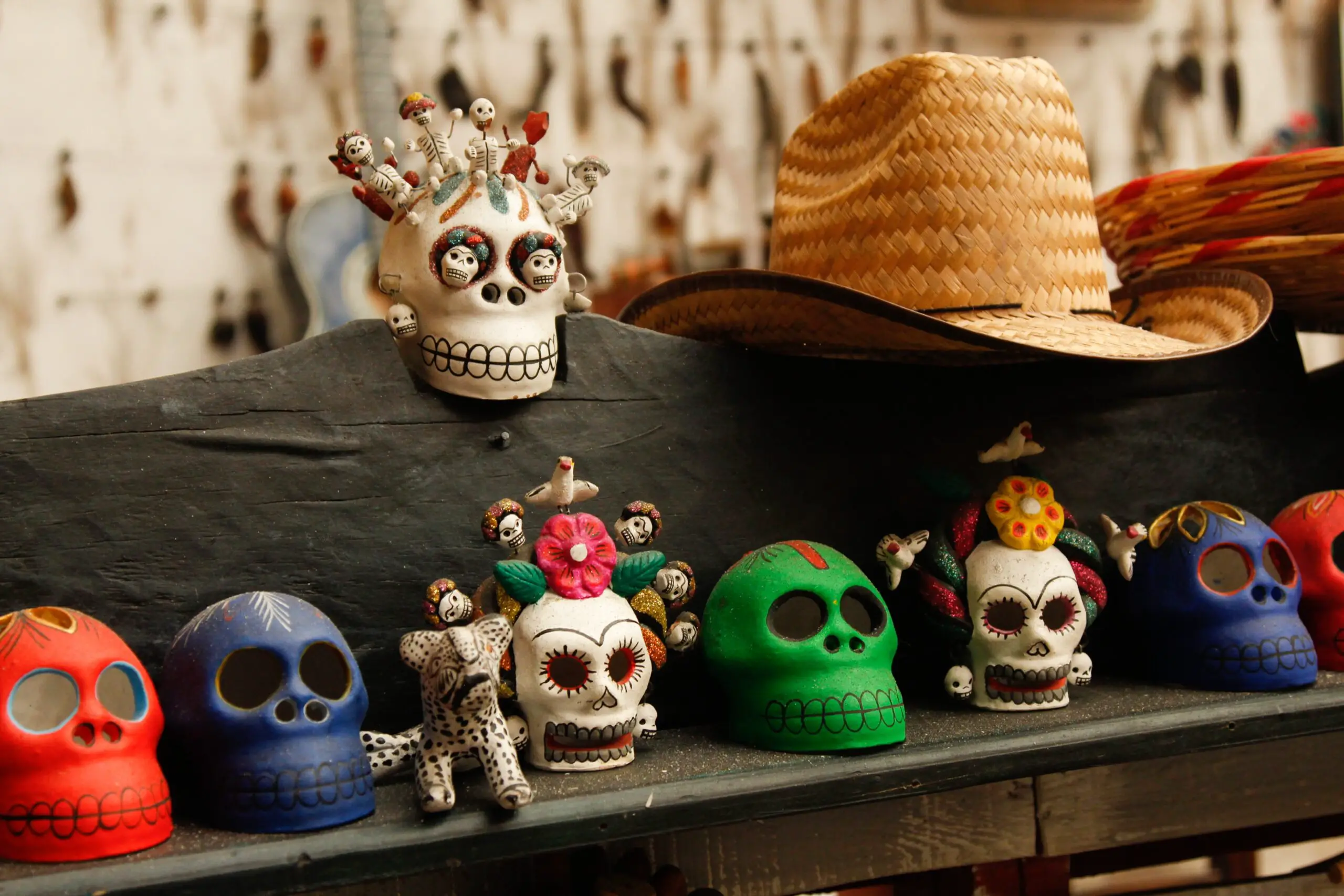While children in the U.S. observe Halloween by going door to door collecting candy, the residents of Oaxaca, Mexico are busy preparing for a very different kind of celebration, derived from a rich mixture of Christian and prehispanic beliefs, symbols and practices.
Rather than hide death away or speak about it in whispers, during Day of the Dead, Oaxacans make it open, public, part of life, even beautiful. Elegantly dressed skeletal figures appear everywhere, engaged in just about every kind of activity. Children gobble down candy skulls, and adults share a special sweet bread, pan de muertos, usually along with a cup of Oaxacan hot chocolate
Oaxacans believe that on the two days following Halloween, the spirits of loved ones who have died come back to visit their families. Angelitos, the spirits of children, return on November 1, while the spirits of departed adults wait until the 2nd.
Table of Contents
Candlelit vigils at flower-covered gravesites
In some communities, such as Xoxocotlan, near the city of Oaxaca, families decorate graves with flowers and candles and spend the night communing with the visiting spirits. Some people sit quietly, while others eat, drink, play music, and sing through the night.
In Xoxocotlan, Atzompa, and other towns where people celebrate the Day of the Dead in this way, the cemeteries, lit by thousands of flickering candles, gravesites covered in orange and yellow marigolds and surrounded by hooded, blanket-draped figures, offer visitors an eerie, other-worldly experience.
Altars laden with food and drink to welcome visiting spirits
Most Oaxacans, however, do not spend the nights of November 1 and 2 at family gravesites. Instead, they invite the spirts of los fieles difuntos, the faithful dead, to come back home to visit.
The vital ingredient for a successful visit is an altar, along with a flower-strewn trail leading to it. Marigolds are the flower of choice for the path and altar, because their strong colors are thought to attract the spirits.
Traditional altars consist of three levels. The upper level, usually formed by an arch made of branches, represents heaven. It will often be decorated with religious images, for example pictures of saints. The lower level represents the earth. It’s usually a table on which are placed photos of the departed along with a wide variety of ofrendas, offerings, which are designed to appeal to specific spirits and provide them with their favorite food and drinks.
Children are lured back with their favorite toys, games, food and drink, while adults may be provided with beer, mezcal (Oaxaca’s answer to tequilla), cigarettes, and of course their favorite dishes.
Traditional Oaxacans take these preparations very seriously. It the food and drink are not well chosen and well prepared, the visiting spirits may get angry and cause trouble, or perhaps just go to someone else’s house.
However much the spirits of the faithful dead enjoy the altars, they are a beautiful addition to Oaxacan homes, bringing a sense of peace and connection with loved ones to family, friends and visitors.
Oaxaca Day of the Dead A Visitors’ Guide

Day of the Dead (Dia de los Muertos) in Oaxaca, Mexico, is one of the most exciting holiday / fiesta times encountered anywhere in the world. While it’s difficult to miss out on any of the major “muertos” activities in Oaxaca without pre – planning, most travelers to Oaxaca for Day of the Dead want advice and assurances, in advance. Accordingly, aside from selecting a hotel or bed & breakfast, and a couple of tours, there’s no need to plan. But with this primer, visitors get a rough idea of what to see when and where – cemeteries, comparsas, altars and tapetes.
Selecting Accommodations for Day of the Dead (Dia de los Muertos) in Oaxaca, Mexico: Hotel & Bed & Breakfast
The importance of reserving a hotel or bed & breakfast early, for Day of the Dead in Oaxaca, cannot be emphasized enough. While some larger hotels seem to have accommodations available right up until a couple of weeks before muertos, hotel occupancy in Oaxaca approaches 85% at this time of year. Therefore, even those who procrastinate should reserve accommodations early, for best lodging selection.
Bed & breakfasts range from as little as one or two rental units, to upwards of ten. This means that for Day of the Dead in Oaxaca, those lodgings providing the best value, and with stellar reputations on Mexican and international travel websites, get booked several months before muertos begins. The same holds true for smaller boutique hotels and budget accommodations.
Visiting Cemeteries In and Around Oaxaca for Day of the Dead
The main downtown Oaxaca cemetery for visiting during Day of the Dead is the Panteón Municipal (Panteón de San Miguel), located near the east end of downtown Oaxaca, walkable from most downtown hotels and B & Bs. For this cemetery, daytime as well as night visits are equally impressive, anywhere from about October 31st, through November 2nd.
Of the village and suburban Oaxaca cemeteries, three stand out. The most popular for tourists is the cemetery at Xoxocotlán, 20 minutes from Oaxaca. It’s traditionally visited on October 31st, anytime that night or evening, or into the early morning hours. As with other cemeteries, many tourists bring a small bouquet of flowers to place on a selected grave, though it’s certainly not required. The pilot for the series FestQuest was shot in this cemetery.
On the same night, but beginning much later, there’s the cemetery in the town of Atzompa, also a short drive from Oaxaca. It’s a quainter Oaxacan cemetery experience. It was the location used for the documentary, Acquainted with the Night.
November 2nd, the cemetery at San Felipe del Agua is the place to be, beginning anytime after dusk, although Oaxacans still bring flowers to decorate graves well after 9 p.m. Whereas at the aforementioned cemeteries the municipalities pay for live music, at San Felipe music is heard from small bands, marimbas and groups of guitar strumming troubadours, hired by individual families. San Felipe is about 15 minutes from downtown Oaxaca.
Photographing is both permissible and expected, but it’s always prudent to request permission at the gravesite.
Comparsas / Parades in Oaxaca for Day of the Dead
Comparsas are parades through the streets of Oaxaca and neighboring villages, with participants often dressed in elaborate costumes, many of which are custom made by expert designers. It’s not unusual for Oaxacans to spend 2,000 – 4,000 pesos for a special costume. Comparsas always include brass bands playing traditional songs, dancing in the streets, and of course imbibing mezcal. One encounters one or more men toting a bottle of mezcal and small plastic cups, passing out the spirit to everyone inclined to have a drink.
Comparsas usually begin in the late afternoon, and continue throughout the night. In Oaxaca comparsas are encountered downtown, and in neighborhoods such as Jalatlaco. In the villages comparsas are usually restricted to a particular night. In Atzompa the comparsa is November 2nd, and in the various Etla villages, November 1st. Regarding the latter, there’s generally a comparsa for each village. Sometimes they converge at or near a designated location.
One characteristic of the comparsa is its tendency to stop at specific households for dancing and music – playing in a large courtyard, then returning to the streets for revelling, then stopping at another household for perhaps an hour for comida (late lunch), then at another later on for cena (dinner), then picking up again. This means that it’s sometimes difficult to select the right time to be heading out to a village; but one invariably comes across comparsas.
Altars and Tapetes for Day of the Dead (Dia de los Muertos) in Oaxaca
Constructing elaborate altars to honor deceased relatives, and hiring someone to prepare a colored sand carpet or tapete, are common practices for Day of the Dead in Oaxaca. Regarding the former, most households and many downtown Oaxaca businesses erect an altar with a sugar cane arch, elaborately decorated with flowers (always including marigolds) and adorned with a photo and the favorite foods of the honored loved one, including his / her preferred beer, mezcal, mole, cigarettes, fruit, and so on. A path of marigold petals guides the soul of the deceased into the business or household, and to the altar.
Oaxaca’s municipal government and some commercial establishments prepare tapetes, sometimes with skulls and skeletons, other times with religious imagery such as the Virgin of the Soledad or Guadalupe. Religious tapetes are usually found in front of cemetery gravesites.
Innumerable Activities & Images in Oaxaca for Day of the Dead (Dia de los Muertos): Cemetery & Street, City & Village, and Much More, but Book Accommodations Early
Visiting cemeteries, participating in comparsas and searching out the most elaborate and thought – provoking tapetes and altars in Oaxaca are but a few of the innumerable Day of the Dead activities available to tourists. A visit to Oaxaca which includes October 31st and the first two days of November inevitably results in memories lasting a lifetime.
Residents of Oaxaca are extremely generous with their time, and for the asking offer their beliefs, feelings and interpretations of the significance of Day of the Dead. Don’t be shy. Learn how Dia de los Muertos in Oaxaca, Mexico, represents a fascinating fusion of indigenous Zapotec tradition and Catholic religious belief, not to be missed; but book hotels and bed & breakfasts early.

It’s not a matter of where, but when. Time is precious and my time spent living and experience the cultures of this world is what I lust for. This is why I created this website, to share true, genuine experiences and not just typical touristy info. Travel, the love of coffee, and food!
